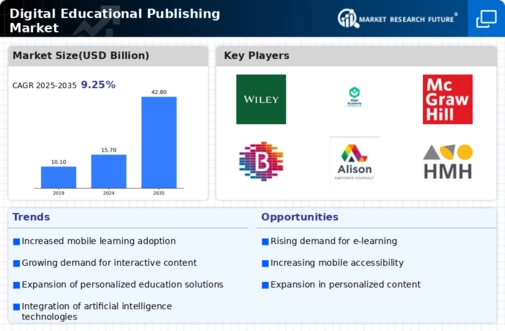Market Growth Projections
The Global Digital Educational Publishing Market Industry is poised for substantial growth, with projections indicating a market value of 15.7 USD Billion in 2024 and an anticipated rise to 42.8 USD Billion by 2035. This growth trajectory suggests a robust demand for digital educational resources, driven by various factors such as technological advancements, government initiatives, and the increasing popularity of e-learning solutions. The industry is expected to experience a compound annual growth rate (CAGR) of 9.51% from 2025 to 2035, reflecting the ongoing transformation of educational publishing in response to evolving learner needs and preferences.
Government Initiatives and Funding
Government initiatives and funding significantly influence the Global Digital Educational Publishing Market Industry. Many countries are prioritizing digital education as part of their national strategies, allocating resources to enhance educational infrastructure. For example, various governments are investing in digital literacy programs and providing grants to educational institutions for adopting digital resources. This support not only fosters a conducive environment for digital publishing but also encourages collaboration between public and private sectors. As a result, the market is expected to thrive, with a projected CAGR of 9.51% from 2025 to 2035, reflecting the positive impact of these initiatives on the industry.
Increased Focus on Lifelong Learning
The Global Digital Educational Publishing Market Industry is witnessing a shift towards lifelong learning, driven by the need for continuous skill development in a rapidly changing job market. As individuals seek to enhance their qualifications and adapt to new technologies, digital educational resources are becoming increasingly popular. This trend is evident in the rise of online courses and professional development programs offered by various platforms. Educational publishers are responding by creating content that caters to adult learners, thus expanding their target audience. This focus on lifelong learning is likely to contribute to the industry's growth, with projections indicating a market value of 42.8 USD Billion by 2035.
Growing Popularity of Mobile Learning
The Global Digital Educational Publishing Market Industry is significantly impacted by the growing popularity of mobile learning. With the widespread use of smartphones and tablets, learners are increasingly accessing educational content on-the-go. This trend is reshaping how educational materials are consumed, leading to the development of mobile-friendly resources and applications. Publishers are adapting their offerings to meet the demands of mobile users, ensuring that content is accessible and engaging across various devices. As mobile learning continues to gain traction, it is expected to drive market growth, contributing to the overall expansion of the industry in the coming years.
Rising Demand for E-Learning Solutions
The Global Digital Educational Publishing Market Industry experiences a notable increase in demand for e-learning solutions, driven by the need for flexible and accessible education. In 2024, the market is projected to reach 15.7 USD Billion, reflecting a growing preference for digital formats among learners and educators. This shift is largely attributed to the proliferation of internet access and mobile devices, which facilitate online learning. Educational institutions are increasingly adopting digital resources to enhance student engagement and improve learning outcomes. As a result, the industry is expected to expand significantly, with a projected CAGR of 9.51% from 2025 to 2035.
Technological Advancements in Educational Tools
Technological advancements play a crucial role in shaping the Global Digital Educational Publishing Market Industry. Innovations such as artificial intelligence, augmented reality, and interactive content are transforming traditional educational methods. These technologies enable personalized learning experiences, catering to diverse learning styles and needs. For instance, AI-driven platforms can analyze student performance and adapt content accordingly, enhancing the overall learning experience. As educational publishers invest in these technologies, the market is likely to witness substantial growth, with projections indicating a rise to 42.8 USD Billion by 2035. This evolution suggests a shift towards more engaging and effective educational resources.























